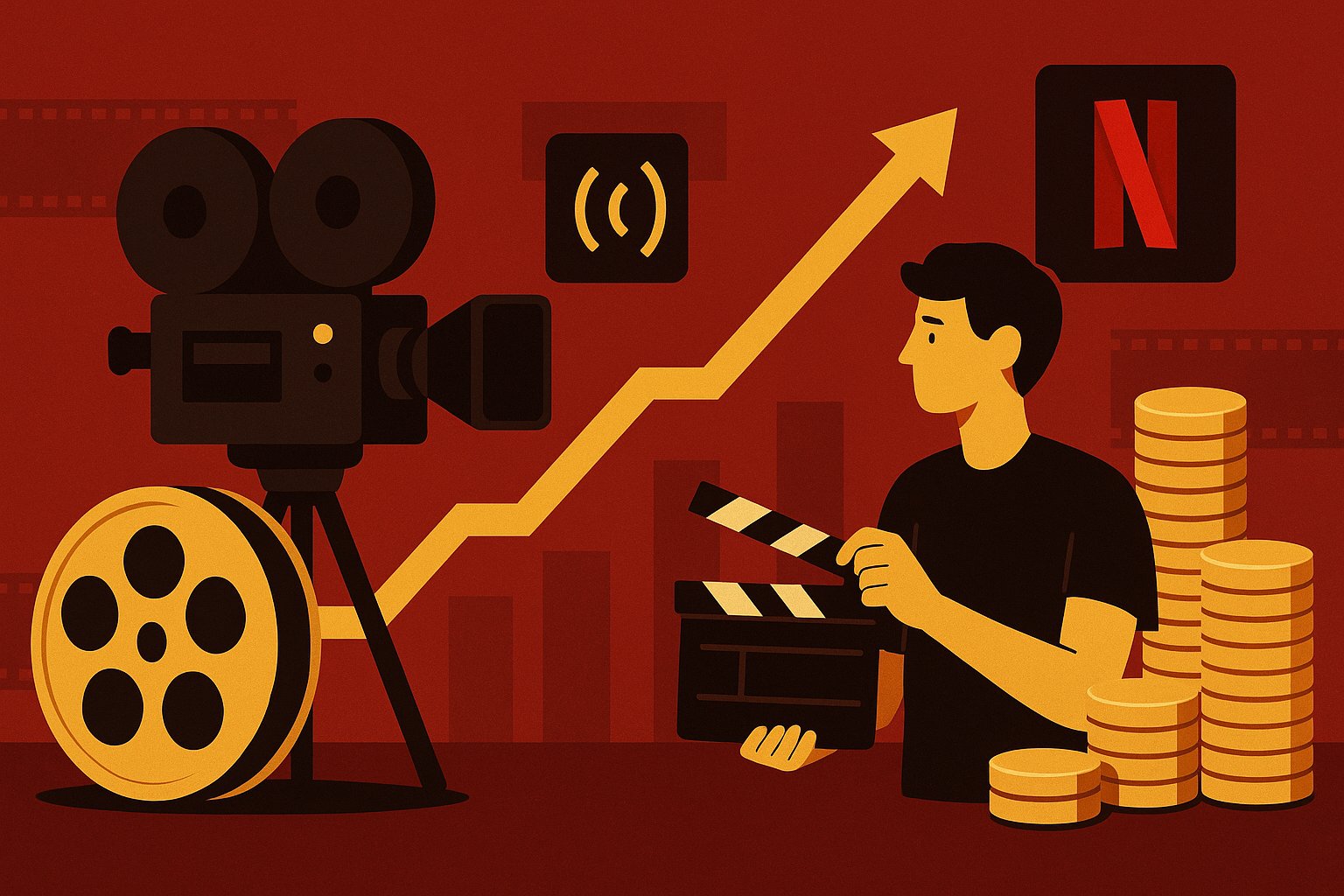The Changing Landscape of Film Financing
A decade ago, emerging filmmakers navigated a labyrinth of financing hurdles—bank loans, grant applications, and the elusive quest for studio backing. The path from script to screen was strewn with gatekeepers demanding bankable pedigree or proven track records. Independent voices with innovative stories often struggled to secure budgets adequate to realize their creative visions. Traditional financing structures offered little flexibility, requiring filmmakers to compromise artistic integrity in favor of commercial safety nets. In this environment, profit participation deals were the realm of seasoned directors and A-list talent, leaving emerging auteurs on the sidelines. Netflix’s entry as a major streamer and financier disrupted this paradigm, introducing a new breed of profit-sharing agreements that democratized access and rewrote the rules of risk and reward.
Netflix’s Bold Bet on Participatory Profits
Netflix’s strategy hinged on a radical proposition: invite filmmakers to share in the upside of a project, rather than merely receive flat fees or linear back-end percentages buried in confusing “Hollywood accounting.” By offering transparent profit participation deals, Netflix signaled a willingness to invest in fresh talent and share financial success proportionally. This approach harnessed Netflix’s subscription revenues and data insights to underwrite a diverse slate of films, from micro-budget indies to mid-range thrillers. The promise of direct financial participation empowered creators to think beyond minimal recoupment targets, aligning their ambitions with Netflix’s goal of generating subscriber engagement and global buzz. It was a gamble on creative potential that would soon pay dividends in both artistic innovation and audience growth.
Demystifying Profit Participation Deals
At their core, Netflix’s participatory profit deals grant filmmakers a percentage of net or gross profits once the film meets predefined thresholds. Unlike opaque studio contracts that obscure true profitability, Netflix structures these deals with clear definitions: revenue sources, allowable deductions, and payout waterfalls are spelled out in plain language. Filmmakers earn “points” on the back end—each point representing one percent of the profit pool—after an agreed-upon recoupment of production and marketing investments. By guaranteeing that points translate into actual dollars tied to viewership metrics and subscriber retention, Netflix provides creators with reliable financial upside. This clarity not only incentivizes high-quality storytelling but also fosters trust between filmmakers and the streaming giant, a rarity in traditional Hollywood relationships.
Aligning Incentives: Creative Freedom Meets Financial Reward
Netflix’s model achieves a delicate balance: it grants filmmakers unparalleled creative latitude while aligning their incentives with the platform’s business objectives. Without the pressure of box-office guarantees, directors can explore unconventional narratives or emerging genres, secure in the knowledge that audience engagement directly benefits their bottom line. Simultaneously, Netflix leverages its global reach and recommendation algorithms to maximize viewership, ensuring that profit pools grow as subscribers immerse themselves in new works. This synergy between creative autonomy and financial reward cultivates a virtuous cycle—innovative films attract curious viewers, boosting subscriber retention and amplifying the creator’s earnings. For emerging filmmakers, this alignment transforms their role from hired hands to entrepreneurial partners.
Democratizing Access: Opening Doors for New Voices
One of the most profound impacts of Netflix’s profit participation program is its democratizing effect on access to resources. Filmmakers from underrepresented backgrounds—women directors, creators of color, LGBTQ+ voices—historically faced added barriers in studio boardrooms. Netflix’s data-driven approach identifies underserved audiences eager for fresh perspectives, greenlighting projects that might have been dismissed by risk-averse financiers. Profit participation deals give these creators a stake in success, erasing the zero-sum mentality that often plagued industry negotiations. By valuing unique voices and offering tangible upside, Netflix has broadened the pool of candidates pitching original ideas, sparking a renaissance of authentic storytelling that resonates across cultures and geographies.
Unpacking the Deal Structure: Points, Thresholds, and Waterfalls
While each Netflix deal is bespoke, most profit participation agreements share common elements: an initial recoupment threshold, a tiered profit waterfall, and defined revenue streams. First, Netflix recoups its production and marketing outlays—often called the “investment pool.” Once that threshold is crossed, profit points kick in: filmmakers receive a set percentage of additional revenues. Waterfall structures then dictate successive tiers, with points sometimes escalating for exceptional performance metrics, such as crossing milestone viewership thresholds. Revenue streams include subscription fees, licensing revenues in select territories, and merchandise sales tied to successful properties. The transparency of these mechanics empowers filmmakers to forecast earnings scenarios, invest personal resources wisely, and negotiate adjustments based on changing market conditions or marketing budgets.
Case Studies: Breakthrough Films and Filmmakers
The power of Netflix’s profit participation model is best illustrated by the success stories it has helped forge. Consider “Mudbound,” an indie period drama that premiered to critical acclaim and multiple Academy Award nominations. Director Dee Rees not only achieved global visibility but also enjoyed a handsome back-end payout, thanks to robust viewership in North America and Europe. Similarly, the debut feature from a young Latin American filmmaker, “Roma” by Alfonso Cuarón, translated record-breaking streams and awards buzz into substantial profit points, elevating the director’s production company for future projects. Emerging genre talents in horror and sci-fi, such as the creators of “Bird Box,” reported that profit participation bonuses significantly outstripped their initial production fees, fueling their next ventures outside Netflix with greater creative control.
The Role of Data-Driven Greenlighting
Central to Netflix’s success is its unparalleled access to viewer data—metrics on completion rates, drop-off points, demographic engagement, and social media buzz. By feeding this intelligence into its greenlighting process, Netflix identifies projects with high audience affinity, allocating profit participation deals to films with strong predictive indicators. Emerging filmmakers benefit from this data mentorship, receiving insights on target demographics and optimal release strategies. This symbiosis reduces the gamble inherent in film production, allowing creators to tailor promotional campaigns that amplify subscriber response. As a result, profit pools grow more predictably, and filmmakers can optimize narrative elements or cast selections to maximize points accrual, all guided by data rather than intuition alone.
Strategic Collaborations and Producer Partnerships
Netflix’s participatory model often extends beyond the director to include producers, cinematographers, and key creative collaborators in the profit pool. By distributing points across a project’s core team, Netflix fosters a collaborative culture where everyone has skin in the game. Producers gain incentive to secure high-caliber talent and manage budgets efficiently, knowing that streamlined costs translate into more points for all. Cinematographers and writers, traditionally salaried roles, now have the opportunity to partake in a film’s financial success. This democratization of profit participation elevates team morale and encourages cross-functional cooperation, as each member’s earnings become directly tied to the film’s performance on the platform.
Navigating Challenges: Balancing Risk and Reward
Despite its many advantages, Netflix’s profit participation model is not without challenges. Filmmakers shoulder greater risk if their films underperform relative to marketing spend, potentially earning less than a traditional fee arrangement. Negotiating fair recoupment thresholds and point structures requires financial acumen and legal counsel—a steep learning curve for first-time directors. Disputes can arise over categorizing expenditure as production versus marketing, affecting when and how payouts begin. To mitigate these risks, savvy filmmakers engage experienced entertainment attorneys, insist on audit rights, and use scenario modeling to understand best- and worst-case outcomes. This due diligence ensures that profit participation remains a pathway to empowerment rather than a gamble with their careers on the line.
Legal and Contractual Considerations for Filmmakers
The complexity of profit participation agreements necessitates rigorous legal scrutiny. Clear definitions of revenue streams—subscription revenues, ancillary licensing, international P&Ls—prevent surprises when calculating net profits. Contracts must outline audit rights, dispute-resolution mechanisms, and data-access protocols so creators can verify viewership figures underpinning their payouts. Intellectual property clauses ensure that rights revert to the filmmaker under specified conditions, safeguarding future distribution opportunities. Attorneys specializing in entertainment law play a pivotal role, negotiating carve-outs—such as excluding merchandise revenues or tax-incentive revenues from the profit pool—to maximize points value. By approaching contracts with a comprehensive legal strategy, filmmakers protect their creative and financial interests from unforeseen pitfalls.
Amplifying Career Trajectories: Beyond the First Deal
A successful Netflix profit participation deal becomes more than a single windfall—it’s a launchpad for sustained career growth. Emerging filmmakers leverage back-end earnings to finance passion projects, attract A-list collaborators, and secure development deals with other studios. The visibility afforded by Netflix’s global platform, combined with tangible earnings, transforms their resumes and bargaining power. Agents and managers cite profit participation payouts as proof of market appeal, commanding higher fees and creative control in subsequent negotiations. Over time, filmmakers convert profit points into equity stakes in production companies, further aligning their long-term financial interests with the content they create. In this way, Netflix’s model fosters entrepreneurial mindsets, broadening the possibilities for independent cinema.
Netflix’s Global Reach and Impact on Independent Cinema
Netflix operates in over 190 countries, delivering localized marketing, subtitled versions, and region-specific promotional campaigns that amplify a film’s reach. For independent filmmakers, this global footprint translates into revenue diversification: point earnings accrue from multiple territories, smoothing regional market fluctuations. Films that might have fizzled in limited theatrical runs gain new life on the platform, attracting fans in unexpected markets. This expansive distribution not only boosts profit pools but also feeds cultural exchange, introducing audiences worldwide to diverse storytelling traditions. The resulting ecosystem nurtures a vibrant independent cinema scene, where emerging talents find sustainable revenue models and creative validation on a truly international stage.
Future Frontiers: Evolving Profit Participation Models
As streaming continues its meteoric rise, Netflix and its competitors are poised to refine profit participation mechanisms. Emerging trends include tiered point systems that escalate rewards for films achieving longevity—viewership benchmarks months after release—rather than initial splash. Hybrid models may combine fixed-fee advances with point participation to mitigate filmmaker risk while preserving upside. Blockchain technology offers possibilities for transparent smart contracts that automate point calculations and payouts based on immutable streaming data. Additionally, cross-platform profit pools could emerge, aggregating revenues from linear TV, home entertainment, and streaming into unified participatory deals. These frontiers will further empower filmmakers, ensuring that creative vision and financial success remain intertwined.
A New Era for Filmmaker Empowerment
Netflix’s profit participation deals have rewritten the script for emerging filmmakers, dismantling old barriers and forging a genuine partnership ethos. By aligning financial incentives with creative ambition, Netflix has proven that sharing success breeds innovation, fosters diversity, and fuels sustainable cinematic ecosystems. The clarity of revenue definitions, the leverage of data-driven greenlighting, and the global reach of the platform combine to create unprecedented opportunities for auteurs worldwide. As profit participation models evolve, filmmakers equipped with legal savvy, strategic collaborations, and audience engagement strategies will continue to thrive. In this new era, the most compelling stories are not only heard—they’re rewarded, celebrated, and shared with the world on terms that honor both artistry and entrepreneurship.




